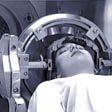 New radiosurgery tool debuts at UC Davis A radiosurgery tool which will allow neurosurgeons to perform bloodless brain surgery will make its U.S. debut at UC Davis Medical Center later this year. The 22-ton rotating gamma system works on the same principals as its more well-known competitor, the gamma knife, but it is safer, easier to use and more comfortable for the patient, according to John Earle, chair of the Department of Radiation Oncology. The machine, which has been used in China since 1992, sends gamma rays generated by cobalt-60 to targeted areas of the brain. The beams, which hit tissues in different angles and directions, are weak enough to pass harmlessly through tissue, but they converge to deliver a powerful dose of radiation with pinpoint accuracy. It is most commonly used to treat patients with brain lesions of less than four centimeters. It is also used to treat acoustic neuromas, meningiomas, gliomas, trigeminal neuralgia and arterious malformations. UC Davis Medical Center is acquiring the equipment as part of a research and development partnership with the manufacturer, OUR Scientific International, Inc. of Pleasanton. The medical center will be collaborating on research projects using the device to help patients with brain tumors and may explore functional brain diseases such as Bell's palsy and Parkinson's disease. The procedure is akin to stereotactic radiosurgery in that the patient's head needs to be held rigid inside a metal frame. Computerized imaging systems establish coordinates for the tissue to be destroyed, while sparing healthy tissue. It is a non-invasive, outpatient alternative for traditional brain surgery for patients with specific medical problems, for those whose tumors are in a location that makes surgery risky, or for those too sick to undergo traditional surgery. Treating with the rotating gamma system is bloodless and noninvasive, is performed on an outpatient basis, and requires only mild sedation for the patient.
Home |
Table of Contents |
To our Readers |
Building on Basics UC Davis Health System | © 2000, 2001, 2002 UC Regents. All rights reserved. |
 |
